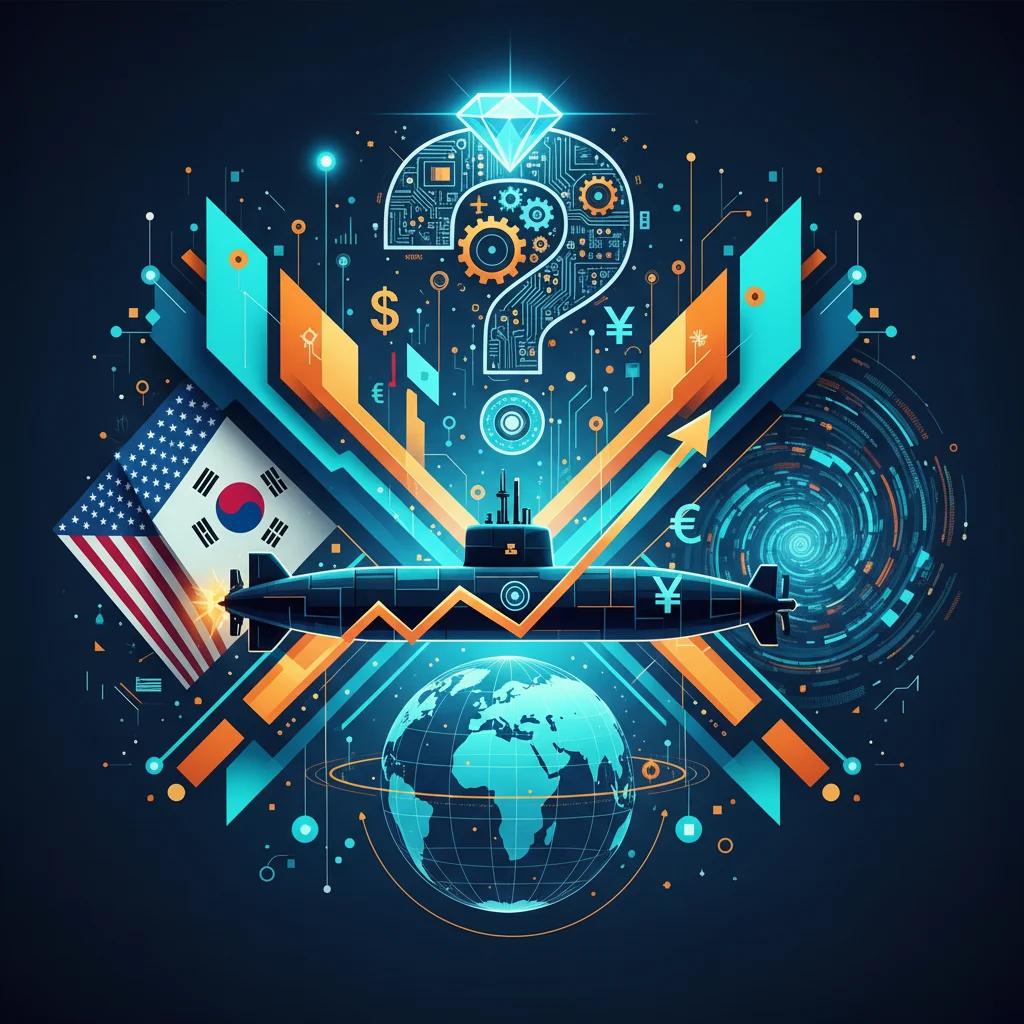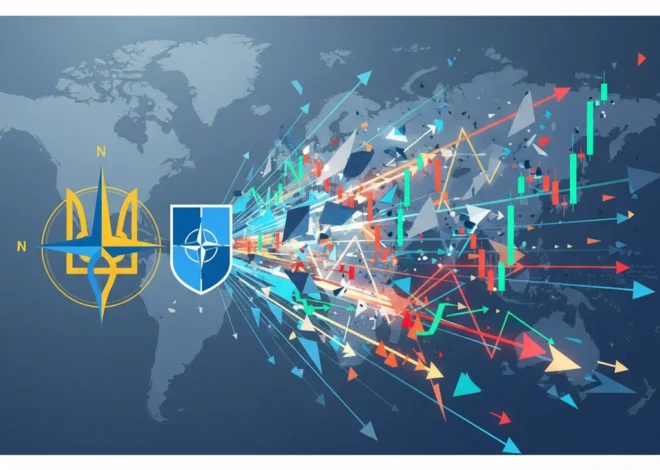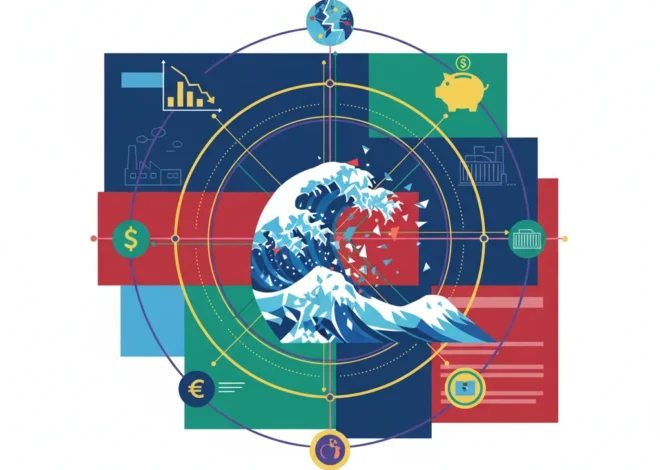
The Trillion-Dollar Question: How a US-South Korea Nuclear Sub Deal Could Reshape Global Investing
A Geopolitical Gambit with Global Financial Consequences
In the high-stakes world of international relations, words from political leaders can move markets as much as any central bank announcement. A recent statement by former President Donald Trump, indicating that the United States could build nuclear-powered submarines for South Korea, is a prime example. While it may seem like a distant military affair, this single pronouncement has sent ripples through the corridors of global finance, forcing investors and business leaders to re-evaluate the strategic and economic landscape of the Indo-Pacific—a region responsible for an estimated 60% of global GDP.
The original report from the Financial Times highlights that such an announcement “could rattle China” and follows persistent pressure from Seoul to bolster its defense capabilities. But the implications extend far beyond military posturing. This potential deal represents a tectonic shift in US foreign policy, regional power dynamics, and, crucially, the flow of capital. For anyone involved in investing, international trade, or corporate strategy, understanding the multifaceted fallout from this development is no longer optional—it’s essential for navigating future risk and opportunity.
This analysis will delve into the profound economic and financial implications of a US-South Korea nuclear submarine agreement. We will explore its impact on the defense sector’s stock market performance, the stability of critical global supply chains, the intricate economics of international arms deals, and the new calculus of geopolitical risk that every investor must now consider.
Why Nuclear-Powered Submarines are a Strategic and Economic Game-Changer
To grasp the financial significance of this announcement, one must first understand the technological and strategic leap it represents. Unlike conventional diesel-electric submarines, which must surface regularly to recharge batteries, nuclear-powered submarines (SSNs) operate with near-limitless endurance. This single difference fundamentally alters the balance of power.
Here’s a breakdown of the key differences and their strategic implications:
| Feature | Conventional (Diesel-Electric) Submarines | Nuclear-Powered Submarines (SSNs) |
|---|---|---|
| Endurance & Range | Limited; must surface or “snorkel” to run diesel engines and recharge batteries every few days. Range is typically a few thousand miles. | Virtually unlimited; constrained only by crew food supplies. Can stay submerged for months and travel hundreds of thousands of miles. |
| Speed | Slower, especially when submerged on battery power. | Significantly faster, allowing for rapid deployment across vast oceanic theaters. |
| Stealth | Extremely quiet on battery power, but vulnerable when recharging. | Continuously powered and can remain deep, making them exceptionally difficult to detect. |
| Cost & Complexity | $500 million – $1 billion per vessel. Simpler technology. | $3 billion – $5 billion+ per vessel. Requires highly advanced nuclear technology and infrastructure. |
Granting South Korea, a non-nuclear-weapon state, access to this technology is a monumental step. The only precedent is the AUKUS pact, where the US and UK agreed to help Australia acquire SSNs. Repeating this for South Korea would signal a new, more muscular US-led alliance network in Asia, aimed squarely at countering China’s naval expansion and North Korea’s provocations. This escalation in strategic capability carries an enormous price tag, promising a windfall for the defense industry but also introducing significant instability into the global economy.
The State Strikes Back: Why the Nexperia Takeover Signals a New Era for Global Investing
The Economic Ripple Effect: A Sector-by-Sector Analysis
A multi-billion dollar defense deal of this magnitude would not occur in a vacuum. Its shockwaves would be felt across numerous sectors, creating clear winners and losers and demanding a recalibration of investment strategies.
1. The Defense and Aerospace Sector: A Bull Market for Arms
The most immediate beneficiaries would be the prime contractors in the naval defense space. In the US, giants like General Dynamics Electric Boat and HII’s Newport News Shipbuilding are the only two shipyards capable of building nuclear-powered submarines. A deal would likely involve a joint venture or significant technology transfer, benefiting not only these titans but also their vast ecosystem of suppliers. Investors engaged in stock trading would quickly price in multi-year revenue streams for these firms.
In South Korea, this would be a transformative event for its burgeoning defense industry, led by companies like Hanwha Ocean (formerly Daewoo Shipbuilding & Marine Engineering). Gaining nuclear propulsion technology would catapult South Korea into the top tier of global naval exporters. According to the Stockholm International Peace Research Institute (SIPRI), South Korea’s arms exports have already surged, and this would supercharge that trend.
2. Supply Chain and Technology: Semiconductors at Sea
The Indo-Pacific is the world’s artery for maritime trade and the heart of the semiconductor supply chain. South Korea is home to Samsung and SK Hynix, two of the world’s largest memory chip manufacturers. Increased militarization of the waters through which nearly all advanced electronics pass raises the risk profile for these critical industries. A potential conflict or even a minor naval incident in the South China Sea or Taiwan Strait could trigger a supply chain crisis dwarfing the disruptions seen during the pandemic. This adds a new layer of geopolitical risk to tech portfolios heavily weighted in the region.
3. Banking and Finance: Funding the Fleet
A fleet of nuclear submarines could cost tens of billions of dollars over its lifecycle. This requires sophisticated financing structures, likely involving government bonds, international loans, and complex agreements managed by major banking institutions. The sheer scale of the capital required would create significant business for the financial sector, but it would also represent a massive diversion of national funds. The debate over the economics of “guns vs. butter” would intensify in South Korea, with potential impacts on public spending in other areas.
The End of an Era: Navigating the "Messy" Transition to a Post-American World
The China Factor: Economic Retaliation as a Weapon
Beijing’s reaction is perhaps the most significant variable for the global economy. China would view a fleet of South Korean nuclear submarines on its doorstep as a profound strategic threat. While a military response is a worst-case scenario, economic retaliation is a near certainty. We have seen this playbook before. When South Korea deployed the US THAAD missile defense system, China responded with an unofficial but devastating boycott of South Korean goods, tourism, and entertainment, costing the South Korean economy billions (source).
Potential Chinese responses could include:
- Targeted tariffs on South Korean exports (cars, electronics, chemicals).
- Restricting exports of critical rare earth minerals, essential for high-tech manufacturing.
- Encouraging consumer boycotts of major South Korean brands.
- Creating regulatory hurdles for South Korean companies operating in China.
For international businesses and investors, this creates a minefield. Companies with heavy exposure to both the South Korean and Chinese markets would be caught in the crossfire, forcing a painful re-evaluation of their supply chain and market strategies.
The Future of Defense: Integrating Financial Technology and Blockchain
As defense projects become more globalized and technologically complex, the back-end systems that manage them are also evolving. The procurement, financing, and supply chain management for a project of this scale would heavily rely on advanced financial technology (fintech). Secure cross-border payment systems, sophisticated risk-modeling software, and digital contract management platforms are essential for coordinating between US and South Korean entities.
Furthermore, securing the supply chain for sensitive nuclear technology is paramount. There is growing interest in the defense industry for using blockchain technology to create an immutable ledger for critical components. This would ensure traceability, verify authenticity, and prevent counterfeit or compromised parts from entering the submarine’s construction—a critical safeguard against espionage and sabotage. While not yet standard practice, this represents the next frontier in securing high-stakes international defense collaborations.
Beyond the Shadows: Why It’s Time to Retire the Term 'Shadow Banking'
Conclusion: A New Paradigm for Geopolitical Investing
The potential US-South Korea nuclear submarine deal is more than a defense headline; it is a powerful indicator of a new, more contentious era in global affairs. For investors, finance professionals, and business leaders, the key takeaway is that geopolitical risk is no longer a peripheral concern but a central driver of market behavior and economic outcomes.
Navigating this new environment requires a sophisticated understanding of the interplay between military strategy, technological advancement, and international finance. Whether this specific deal materializes or not, the underlying tensions it represents are here to stay. Investors must now factor in the possibility of regional arms races, economic coercion, and supply chain fractures as core components of their risk management framework. The anouncement serves as a stark reminder that in today’s interconnected world, a decision made in Washington about submarines for Seoul can ultimately determine the success or failure of a portfolio a world away.


